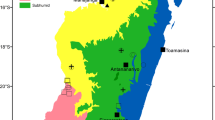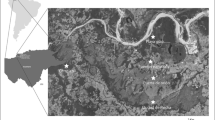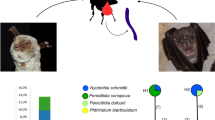Abstract
Bats (order, Chiroptera) account for more than one-fifth of all mammalian species in the world and are infected by various intra-erythrocytic parasites of the family Plasmodiidae (Apicomplexa: Haemosporida), including Polychromophilus Dionisi, 1899. Recent advance in the molecular characterization of haemosporidian isolates has enabled their accurate identification, particularly in the last decade. Studies are actively conducted in tropical regions, Europe, and Australia; however, data on haemosporidian infection in bats in Asian temperate areas, including Japan, remain limited. In this study, 75 bats of 4 species (Miniopterus fuliginosus, Myotis macrodactylus, Rhinolophus nippon, and Rhinolophus cornutus) were captured at three sites in western Japan (Yamaguchi Prefecture), and haemosporidian parasites were screened microscopically and molecularly via nested polymerase chain reaction (PCR) targeting the cytochrome b (cytb), cytochrome c oxidase subunit I (cox-1), apicoplast caseinolytic protease C (clpc), and nuclear elongation factor 2 (EF2) genes. The survey detected Polychromophilus melanipherus in 15 (40.5%) miniopterid bats (M. fuliginosus) and Polychromophilus murinus in 6 (46.2%) vespertilionid bats (M. macrodactylus), whereas none of the 25 rhinolophid bats (R. nippon and R. cornutus) was infected, indicating the robust host specificity for miniopterid (P. melanipherus) and vespertilionid (P. murinus) bats regardless of orthotopic nesting. The 15 Polychromophilus cytb sequences obtained from 11 miniopterid and 4 vespertilionid bats were classified into six cytb haplotypes (three for each species), showing no region-specific variation in a phylogenetic tree of Polychromophilus isolates in the Old World. Similarly, multiple haplotypes (seven for cox-1 and nine for clpc) and genotypes (three for EF2) were characterized for the Japanese isolates of Polychromophilus, and the results were consistent with those based on a haemosporidian cytb analysis. Bat flies (Nycteribia allotopa and another undetermined Nycteribia sp.) collected from the body surface of bats harbored Polychromophilus oocysts on the external surface of the midgut. This is the first study to report the isolation and molecular characterization of Polychromophilus spp. in miniopterid and vespertilionid bats in the temperate area of Asia (western Japan). Future studies should evaluate the global prevalence of haemosporidian infections in bats.






Similar content being viewed by others
References
Adam JP, Landau I (1973) Developmental stages of Polychromophilus sp., a parasite of insectivorous bats from the Congo-Brazzaville, in the nycteribiid fly Penicillidia fulvida Bigot 1889. Trans R Soc Trop Med Hyg 67:5–6
Anisimova M, Gascuel O (2006) Approximate likelihood-ratio test for branches: a fast, accurate, and powerful alternative. Syst Biol 55:539–552
Arnuphapprasert A, Riana E, Ngamprasertwong T, Wangthongchaicharoen M, Soisook P, Thanee S, Bhodhibundit P, Kaewthamasorn M (2020) First molecular investigation of haemosporidian parasites in Thai bat species. Int J Parasitol Parasite Wildl 13:51–61
Borner J, Pick C, Thiede J, Kolawole OM, Kingsley MT, Schulze J, Cottontail VM, Wellinghausen N, Schmidt-Chanasit J, Bruchhaus I, Burmester T (2016) Phylogeny of haemosporidian blood parasites revealed by a multi-gene approach. Mol Phylogenet Evol 94:221–231
Boundenga L, Ngoubangoye B, Mombo IM, Tsoubmou TA, Renaud F, Rougeron V, Prugnolle F (2018) Extensive diversity of malaria parasites circulating in Central African bats and monkeys. Ecol Evol 8:10578–10586
Chumnandee C, Pha-obnga N, Werb O, Matuschewski K, Schaer J (2021) Molecular characterization of Polychromophilus parasites of Scotophilus kuhlii bats in Thailand. Parasitology 148:495–499
Deane LM, Deane MP (1961) Sobre dois hemocitozoarios encontrados em mamiferos silvestres da regiao Amazonica. Rev Inst Med Trop Sao Paulo 3:107–110
Dereeper A, Guignon V, Blanc G, Audic S, Buffet S, Chevenet F, Dufayard JF, Guindon S, Lefort V, Lescot M, Claverie J-M, Gascuel O (2008) Phylogeny.fr: robust phylogenetic analysis for the non-specialist. Nucleic Acids Res 36:465–469
Dew BB, McMillan B (1970) Seasonal variation of Polychromophilus melanipherus (Sporozoa:Haemoproteidae) in the bent-winged bat Miniopterus schreibersii (Chiroptera) in New South Wales. Parasitology 61:161–166
Dick CW, Patterson BD (2006) Bat flies–obligate ectoparasites of bats. In: Morand S, Krasnov B, Poulin RR (eds) Micromammals and macroparasites: from evolutionary ecology to management. Springer-Verlag, Japan, pp 179–194
Duval L, Robert V, Csorba G, Hassanin A, Randrianarivelojosia M, Walston J, Nhim T, Goodman SM, Ariey F (2007) Multiple host-switching of Haemosporidia parasites in bats. Malar J 6:157
Duval L, Mejean C, Maganga GD, Makanga BK, Mangama Koumba LB, Peirce MA, Ariey F, Bourgarel M (2012) The chiropteran haemosporidian Polychromophilus melanipherus: a worldwide species complex restricted to the family Miniopteridae. Infect Genet Evol 12:1558–1566
Eyles DE, Dunn FL, Liat LB (1962) Blood parasites of Malayan bats. Med J Malaysia 17:87–88
Folmer O, Black M, Hoeh W, Lutz R, Vrijenhoek R (1994) DNA primers for amplification of mitochondrial cytochrome c oxidase subunit I from diverse metazoan invertebrates. Mol Mar Biol Biotechnol 3:294–299
Foster GW (1979) Polychromophilus from southeastern brown bats (Myotis austroriparius) in North-Central Florida. J Parasitol 65:465–466
Galen SC, Borner J, Martinsen ES, Schaer J, Austin CC, West CJ, Perkins SL (2018) The polyphyly of Plasmodium: comprehensive phylogenetic analyses of the malaria parasites (order Haemosporida) reveal widespread taxonomic conflict. R Soc Open Sci 5:171780
Gardner RA, Molyneux DH (1988) Polychromophilus murinus: a malarial parasite of bats: life-history and ultrastructural studies. Parasitology 96:591–605
Gardner RA, Molyneux DH, Stebbings RE (1987) Studies on the prevalence of Haematozoa of British bats. Mammal Rev 17:75–80
Garnham PCC (1973a) Polychromophilus species in insectivorous bats. Trans R Soc Trop Med Hyg 67:2–3
Garnham PCC (1973b) The zoogeography of Polychromophilus and description of a new species of a Gregarine (Lankesteria galliardi). Ann Parasitol Hum Comp 48:231–242
Garnham PCC, Lainson R, Shaw JJ (1971) A contribution to the study of the haematozoon parasites of bats. A new mammalian haemoproteid, Polychromophilus deanei n. sp. Mem Inst Oswaldo Cruz 69:119–127
Godfrey RD, Fedynich AM, Pence DB (1987) Quantification of the hematozoa in blood smears. J Wildl Dis 23:558–565
Goedbloed E, Cremers-Hoyer L, Perié NM (1964) Blood parasites of bats in the Netherlands. Ann Trop Med Parasitol 58:257–260
Guindon S, Gascuel O (2003) A simple, fast, and accurate algorithm to estimate large phylogenies by maximum likelihood. Syst Biol 52:696–704
Holz PH, Lumsden LF, Legione AR, Hufschmid J (2019) Polychromophilus melanipherus and haemoplasma infections not associated with clinical signs in southern bent-winged bats (Miniopterus orianae bassanii) and eastern bent-winged bats (Miniopterus orianae oceanensis). Int J Parasitol: Parasit Wildl 8:10–18
Kumar S, Stecher G, Tamura K (2016) MEGA7: Molecular evolutionary genetics analysis version 7.0 for bigger datasets. Mol Biol Evol 33:1870–1874
Landau I, Chabaud AG (1978) Description of P. cyclopsi n. sp. a parasite of the microchiropteran bat Hipposideros cyclops in Gabon. Ann Parasitol Hum Comp 53:247–253
Landau I, Rosin G, Miltgen F, Hugot JP, Leger N, Beveridge I, Baccam D (1980) Sur le genre Polychromophilus (Haemoproteidae, parasite de Microchioptères). Ann Parasitol Hum Comp 55:13–32
Landau I, Baccam D, Ratanaworabhan N, Yenbutra S, Boulard Y, Chabaud AG (1984) Nouveaux Haemoproteidae parasites de Chiroptères en Thailande. Ann Parasitol Hum Comp 59:437–447
Landau I, Chavatte JM, Karadjian G, Chabaud A, Beveridge I (2012a) The haemosporidian parasites of bats with description of Sprattiella alecto gen. nov., sp. nov. Parasite 19:137–146
Landau I, Chavatte JMJ, Beveridge I (2012b) Johnsprentia copemani gen. nov., sp. nov. (Haemoproteidae), a parasite of the flying-fox, Pteropus alecto (Pteropodidae), from Queensland. Mem Queensl Mus 56:61–66
Lutz HL, Patterson BD, Kerbis Peterhans JC, Stanley WT, Webala PW, Gnoske TP, Hackett SJ, Stanhope MJ (2016) Diverse sampling of East African haemosporidians reveals chiropteran origin of malaria parasites in primates and rodents. Mol Phylogenet Evol 99:7–15
Maa TC (1967) A synopsis of Diptera Pupipara of Japan. Pac Insects 9:727–760
Mackerras MJ (1959) The Haematozoa of Australian mammals. Aust J Zool 7:105–135
Marinkelle CJ (1995) The haemoproteid parasite, Bioccala deanei, from a Colombian bat, Eptesicus fuscus (Vespertilionidae). Ann Trop Med Parasitol 89:89–91
Martinsen ES, Perkins SL, Schall JJ (2008) A three-genome phylogeny of malaria parasites (Plasmodium and closely related genera): evolution of life-history traits and host switches. Mol Phylogenet Evol 47:261–273
Martinsen ES, McInerney N, Brightman H, Ferebee K, Walsh T, McShea WJ, Forrester TD, Ware L, Joyner PH, Perkins SL, Latch EK, Yabsley MJ, Schall JJ, Fleischer RC (2016) Hidden in plain sight: cryptic and endemic malaria parasites in North American white-tailed deer (Odocoileus virginianus). Sci Adv 2:e1501486
Megali A, Yannic G, Christe P (2011) Disease in the dark: molecular characterization of Polychromophilus murinus in temperate zone bats revealed a worldwide distribution of this malaria-like disease. Mol Ecol 20:1039–1048
Mer GG, Goldblum N (1947) A haemosporidian of bats. Nature 159:444
Miller-Butterworth CM, Murphy WJ, O’Brien SJ, Jacobs DS, Springer MS, Teeling EC (2007) A family matter: conclusive resolution of the taxonomic position of the long-fingered bats, Miniopterus. Mol Biol Evol 24:1553–1561
Minozzo GA, da Silva MB, Riediger IN, de Oliveira GL, dos Anjos CC, Monteiro EF, dos Santos AP, Biondo AW, Kirchgatter K (2021) First molecular detection of Polychromophilus parasites in Brazilian bat species. Microorganisms 9:1240
Nabeshima K, Sato S, Kabeya H, Komine N, Nanashima R, Takano A, Shimoda H, Maeda K, Suzuki K, Maruyama S (2020) Detection and phylogenetic analysis of Bartonella species from bat flies on eastern bent-wing bats (Miniopterus fuliginosus) in Japan. Comp Immunol Microbiol Infect Dis 73:101570
Nikoh N, Sato M, Kondo N, Fukatsu T (2011) Phylogenetic comparison between nycteribiid bat flies and their host bats. Med Entomol Zool 62:185–194
Obame-Nkoghe JL, Rahola N, Bourgarel M, Yangari P, Prugnolle F, Maganga GD, Leroy E-M, Fontenille D, Ayala D, Paupy C (2016) Bat flies (Diptera: Nycteribiidae and Streblidae) infesting cave-dwelling bats in Gabon: diversity, dynamics and potential role in Polychromophilus melanipherus transmission. Parasit Vectors 9:333
Ohdachi SD, Ishibashi Y, Iwasa MA, Saitoh T (2010) The wild mammals of Japan. Shoukadoh Book Sellers, Kyoto
Perkins SL, Schaer J (2016) A modern menagerie of mammalian malaria. Trends Parasitol 32:772–782
Preble JH, Ohte N, Vincenot CE (2021) In the shadow of the rising sun: a systematic review of Japanese bat research and conservation. Mammal Rev 51:109–126
Ramasindrazana B, Goodman SM, Gomard Y, Dick CW, Tortosa P (2017) Hidden diversity of Nycteribiidae (Diptera) bat flies from the Malagasy Region and insights on host parasite interactions. Parasit Vectors 10:630
Ramasindrazana B, Goodman SM, Dsouli N, Gomard Y, Lagadec E, Randrianarivelojosia M, Dellagi K, Tortosa P (2018) Polychromophilus spp. (Haemosporida) in Malagasy bats: host specificity and insights on invertebrate vectors. Malar J 17:318
Rasoanoro M, Goodman SM, Randrianarivelojosia M, Rakotondratsimba M, Dellagi K, Tortosa P, Ramasindrazana B (2021) Diversity, distribution, and drivers of Polychromophilus infection in Malagasy bats. Malar J 20:157
Rosskopf SP, Held J, Gmeiner M, Mordmüller B, Matsiégui P, Eckerle I, Weber N, Matuschewski K, Schaer J (2019) Nycteria and Polychromophilus parasite infections of bats in Central Gabon. Infect Genet Evol 68:30–34
Sándor AD, Péter Á, Corduneanu A, Barti L, Csősz I, Kalmár Z, Hornok S, Kontschán J, Mihalca AD (2021) Wide distribution and diversity of malaria-related haemosporidian parasites (Polychromophilus spp.) in bats and their ectoparasites in eastern Europe. Microorganisms 9:230
Schaer J, Perkins SL, Decher J, Leendertz FH, Fahr J, Weber N, Matuschewski K (2013) High diversity of West African bat malaria parasites and a tight link with rodent Plasmodium taxa. Proc Natl Acad Sci U S A 110:17415–17419
Schaer J, Reeder DM, Vodzak ME, Olival KJ, Weber N, Mayer F, Matuschewski K, Perkins SL (2015) Nycteria parasites of Afrotropical insectivorous bats. Int J Parasitol 45:375–384
Schaer J, Perkins SL, Ejotre I, Vodzak ME, Matuschewski K, Reeder DM (2017) Epauletted fruit bats display exceptionally high infections with a Hepatocystis complex in South Sudan. Sci Rep 7:6928
Schaer J, McMichael L, Gordon AN, Russell D, Matuschewski K, Perkins SL, Field H, Power M (2018) Phylogeny of Hepatocystis parasites of Australian flying foxes reveals distinct parasite clade. Int J Parasitol: Parasites Wildl 7:207–212
Szentiványi T, Markotter W, Dietrich M, Clément L, Ançay L, Brun L, Genzoni E, Kearney T, Seamark E, Estók P, Christe P, Olivier Glaizot O (2020) Host conservation through their parasites: molecular surveillance of vector-borne microorganisms in bats using ectoparasitic bat flies. Parasite 27:72
Teeling EC, Springer MS, Madsen O, Bates P, O’Brien SJ, Murphy WJ (2005) A molecular phylogeny for bats illuminates biogeography and the fossil record. Science 307:580–584
Thompson JD, Higgins DG, Gibson TJ (1994) CLUSTAL W: improving the sensitivity of progressive multiple sequence alignment through sequence weighting, position-specific gap penalties and weight matrix choice. Nucleic Acids Res 22:4673–4680
Witsenburg F, Salamin N, Christe P (2012) The evolutionary host switches of Polychromophilus: a multi-gene phylogeny of the bat malaria genus suggests a second invasion of mammals by a haemosporidian parasite. Malar J 11:53
Witsenburg F, Schneider F, Christe P (2014) Epidemiological traits of the malaria-like parasite Polychromophilus murinus in the Daubenton’s bat Myotis daubentonii. Parasit Vectors 7:556
Witsenburg F, Clément L, López-Baucells A, Palmeirim J, Pavlinić I, Scaravelli D, Ševčík M, Dutoit L, Salamin N, Goudet J, Christe P (2015) How a haemosporidian parasite of bats gets around: the genetic structure of a parasite, vector and host compared. Mol Ecol 24:926–940
Author information
Authors and Affiliations
Corresponding author
Ethics declarations
Conflict of interest
The authors declare no competing interests.
Additional information
Section Editor: Daniel K Howe
Publisher’s note
Springer Nature remains neutral with regard to jurisdictional claims in published maps and institutional affiliations.
Supplementary Information
Rights and permissions
About this article
Cite this article
Rosyadi, I., Shimoda, H., Takano, A. et al. Isolation and molecular characterization of Polychromophilus spp. (Haemosporida: Plasmodiidae) from the Asian long-fingered bat (Miniopterus fuliginosus) and Japanese large-footed bat (Myotis macrodactylus) in Japan. Parasitol Res 121, 2547–2559 (2022). https://doi.org/10.1007/s00436-022-07592-7
Received:
Accepted:
Published:
Issue Date:
DOI: https://doi.org/10.1007/s00436-022-07592-7





